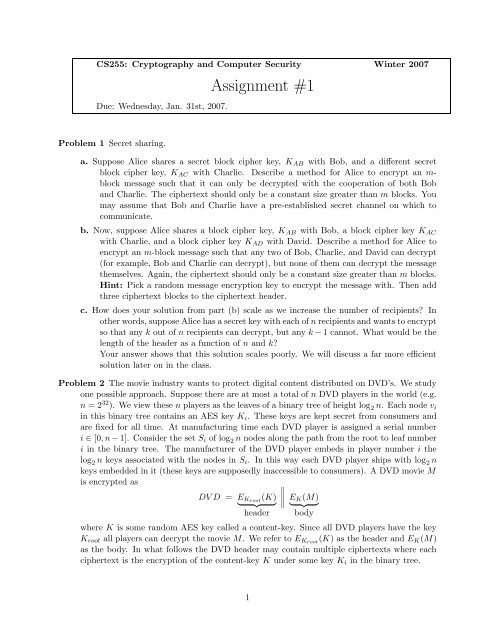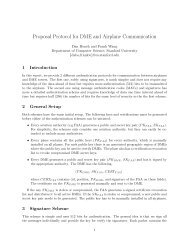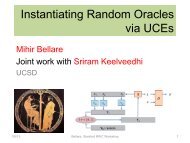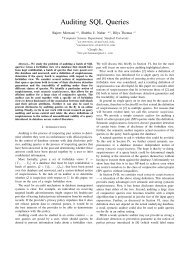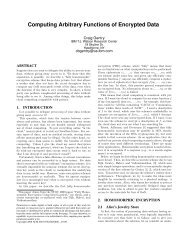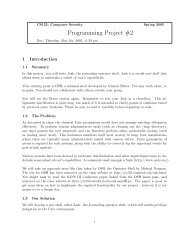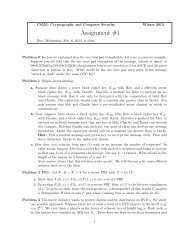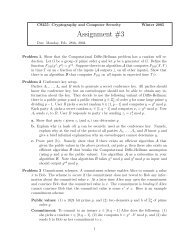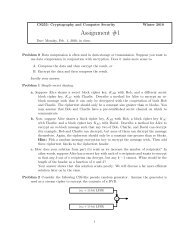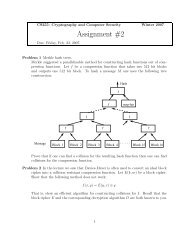Cs255 - Stanford Crypto Group
Cs255 - Stanford Crypto Group
Cs255 - Stanford Crypto Group
You also want an ePaper? Increase the reach of your titles
YUMPU automatically turns print PDFs into web optimized ePapers that Google loves.
CS255: <strong>Crypto</strong>graphy and Computer Security Winter 2007<br />
Due: Wednesday, Jan. 31st, 2007.<br />
Problem 1 Secret sharing.<br />
Assignment #1<br />
a. Suppose Alice shares a secret block cipher key, KAB with Bob, and a different secret<br />
block cipher key, KAC with Charlie. Describe a method for Alice to encrypt an mblock<br />
message such that it can only be decrypted with the cooperation of both Bob<br />
and Charlie. The ciphertext should only be a constant size greater than m blocks. You<br />
may assume that Bob and Charlie have a pre-established secret channel on which to<br />
communicate.<br />
b. Now, suppose Alice shares a block cipher key, KAB with Bob, a block cipher key KAC<br />
with Charlie, and a block cipher key KAD with David. Describe a method for Alice to<br />
encrypt an m-block message such that any two of Bob, Charlie, and David can decrypt<br />
(for example, Bob and Charlie can decrypt), but none of them can decrypt the message<br />
themselves. Again, the ciphertext should only be a constant size greater than m blocks.<br />
Hint: Pick a random message encryption key to encrypt the message with. Then add<br />
three ciphertext blocks to the ciphertext header.<br />
c. How does your solution from part (b) scale as we increase the number of recipients? In<br />
other words, suppose Alice has a secret key with each of n recipients and wants to encrypt<br />
so that any k out of n recipients can decrypt, but any k − 1 cannot. What would be the<br />
length of the header as a function of n and k?<br />
Your answer shows that this solution scales poorly. We will discuss a far more efficient<br />
solution later on in the class.<br />
Problem 2 The movie industry wants to protect digital content distributed on DVD’s. We study<br />
one possible approach. Suppose there are at most a total of n DVD players in the world (e.g.<br />
n = 2 32 ). We view these n players as the leaves of a binary tree of height log 2 n. Each node vi<br />
in this binary tree contains an AES key Ki. These keys are kept secret from consumers and<br />
are fixed for all time. At manufacturing time each DVD player is assigned a serial number<br />
i ∈ [0, n − 1]. Consider the set Si of log 2 n nodes along the path from the root to leaf number<br />
i in the binary tree. The manufacturer of the DVD player embeds in player number i the<br />
log 2 n keys associated with the nodes in Si. In this way each DVD player ships with log 2 n<br />
keys embedded in it (these keys are supposedly inaccessible to consumers). A DVD movie M<br />
is encrypted as<br />
DV D = EKroot(K)<br />
<br />
header<br />
<br />
<br />
<br />
EK(M)<br />
<br />
body<br />
where K is some random AES key called a content-key. Since all DVD players have the key<br />
Kroot all players can decrypt the movie M. We refer to EKroot(K) as the header and EK(M)<br />
as the body. In what follows the DVD header may contain multiple ciphertexts where each<br />
ciphertext is the encryption of the content-key K under some key Ki in the binary tree.<br />
1
a. Suppose the log 2 n keys embedded in DVD player number r are exposed by hackers and<br />
published on the Internet (say in a program like DeCSS). Show that when the movie<br />
industry is about to distribute a new DVD movie they can encrypt the contents of the<br />
DVD using a header of size log 2 n so that all DVD players can decrypt the movie except<br />
for player number r. In effect, the movie industry disables player number r.<br />
Hint: the header will contain log 2 n ciphertexts where each ciphertext is the encryption<br />
of the content-key K under certain log 2 n keys from the binary tree.<br />
b. Suppose the keys embedded in k DVD players R = {r1, . . . , rk} are exposed by hackers.<br />
Show that the movie industry can encrypt the contents of a new DVD using a header<br />
of size O(k log n) so that all players can decrypt the movie except for the players in<br />
R. You have just shown that all hacked players can be disabled without affecting other<br />
consumers.<br />
Problem 3 Let E, D be the encryption/decryption algorithms of a certain block cipher. Consider<br />
the following chaining method for double DES like encryption:<br />
k<br />
m1<br />
k1 E<br />
k2 E<br />
C 1<br />
k 1<br />
k 2<br />
m2<br />
E<br />
E<br />
C 2<br />
The secret key is a triple (k, k1, k2) where k is as long as E’s block size (64 bits for DES) and<br />
k1, k2 are as long as E’s key size (56 bits for DES). For example, when E is DES the total key<br />
size is 64+56+56 = 176 bits.<br />
a. Describe the decryption circuit for this system.<br />
b. Show that using two short chosen ciphertext decryption queries an attacker can recover<br />
the full key (k, k1, k2) in approximately the time it takes to run algorithm D 2 ℓ times<br />
(i.e. the attack running time should be O(2 ℓ time(D)). Here ℓ is the block cipher’s keylength<br />
(56 bits for DES). Your attack shows that this system can be broken much faster<br />
than exhaustive search.<br />
k 1<br />
k 2<br />
Hint: Consider the two decryption queries 〈C1, C2, C3, C4〉 and 〈C ′ 1 , C2, C ′ 3 , C4〉 where<br />
C1, . . . , C4 and C ′ 1 , C′ 3 are random ciphertext blocks.<br />
Problem 4 Traitor tracing. Satellite content providers (such as satellite radio) often use hardware<br />
players to enforce specific usage policy (e.g. the content cannot be saved after it is played).<br />
Player i contains an encryption key Ki that it uses to decrypt and play the broadcast content.<br />
Now suppose some user j breaks open his player, recovers key Kj, and builds a pirate player P<br />
that decrypts and saves all broadcast content in the clear. When this pirate player P is<br />
somehow found, the content provider would like to tell whose key Kj was used to construct P<br />
(supposedly, this user j will have to answer some tough questions). Finding the key Kj that<br />
was used to build P is called tracing and the key Kj is called the traitor key.<br />
Let n = 32 and suppose there are at most 2 n players in existence. Consider the following<br />
encryption system:<br />
2<br />
m3<br />
E<br />
E<br />
C 3<br />
k 1<br />
k 2<br />
m4<br />
E<br />
E<br />
C 4
Setup: generate 2n keys:<br />
k0,0 k1,0 k2,0 · · · kn−1,0<br />
k0,1 k1,1 k2,1 · · · kn−1,1<br />
Player number ℓ (for ℓ = 0, 1, . . . , 2 n −1) is given key Kℓ defined as follows. Let bn−1bn−2 . . . b0 ∈<br />
{0, 1} n be the binary representation of ℓ (so that ℓ = n−1<br />
i=0 bi2 i ). Then key Kℓ is<br />
Kℓ = ( k0,b0 , k1,b1 , . . . , kn−1,bn−1 )<br />
Encrypt: to transmit content m, the content provider picks a random i ∈ {0, 1, . . . , n − 1}<br />
and broadcasts via satellite the ciphertext:<br />
C = ( i, E(ki,0, m), E(ki,1, m) )<br />
a. Show that all players ℓ = 0, 1, . . . , 2 n − 1 can decrypt the broadcast and obtain m.<br />
b. Suppose key Kj is used to create a pirate decoder P . Show that the content provider<br />
can use P as a black-box and recover the index j. The content owner need not reverse<br />
engineer player P — it only uses P as a black box feeding it ciphertexts and observing the<br />
result. We are assuming that users do not collude so that P is created using knowledge<br />
of a single secret key Kj.<br />
Hint: try to recover one bit of j at a time by feeding P a total of n carefully crafted<br />
ciphertexts C0, C1, . . . , Cn−1.<br />
c. Suppose a pirate is able to obtain two player keys Ki and Kj for some i, j (where i ⊕ j is<br />
not a power of 2). Show how the pirate can build a player P that will evade detection by<br />
your tracing algorithm from part (b). That is, your tracing algorithm will fail to output<br />
either i or j.<br />
Side note: traitor tracing is a somewhat evil use of cryptography. Fortunately, traitor tracing<br />
systems have a number of applications unrelated to content protection.<br />
Problem 5 Consider the following CSS-like pseudo random generator. Assume the generator is<br />
used as a stream cipher to encrypt the contents of a DVD.<br />
(n1 + 1)-bit LFSR<br />
(n2 + 1)-bit LFSR<br />
The secret key is n = n1 + n2 bits (recall that n1 = 16 and n2 = 24 for CSS). The top LFSR<br />
is initialized with 1k1 where k1 is the left most n1 bits of the key. The bottom LFSR is<br />
initialized with 1k2 where k2 is the right most n2 bits of the key. The output of the two<br />
LFSR’s is Xored and the resulting bit stream is the pseudo random sequence used to encrypt<br />
the plaintext. Show that an attacker who is only given the initial 2n bits of output of this<br />
generator can produce the rest of the output sequence in time approximately 2 min(n1,n2) .<br />
Hint: Do an exhaustive search on all possible states of one LFSR and try to deduce the state<br />
of the other LFSR.<br />
An exhaustive search attack takes time 2 n to produce the entire output sequence. Your<br />
attack is much faster. For CSS, your attack takes approximately 2 16 steps which is only a few<br />
milliseconds on a modern processor. Consequently, the resulting stream cipher is completely<br />
insecure once a few bits of a plaintext/ciphertext pair are known.<br />
3<br />
+
Problem 6 Given a cipher (E, D), define the randomized cipher (F, G) by<br />
F (k, m) := (E(k, r), r ⊕ m),<br />
where r is a random bit string of the same length as the message. That is, the output of<br />
F (k, m) is the encryption of a random one-time pad along with the original message XORed<br />
with the random pad. A new independent random pad r is chosen for every encryption. The<br />
decryption algorithm G(k, (c1, c2)) works by first running D(k, c1) to recover r and then<br />
recovering m from c2.<br />
We consider two attack models. The goal of both models is to reconstruct the actual secret<br />
key k (this is a very strong goal – one might be able to decrypt messages without ever learning<br />
k).<br />
• In the key-reconstruction chosen plaintext attack (KR-CPA), the adversary is allowed to<br />
issue q message queries m1, m2, . . . , mq and for each mi learn the encryption of mi.<br />
• In the key-reconstruction random plaintext attack (KR-RPA), the adversary is given q<br />
random plaintext/ciphertext pairs.<br />
Note that for F (k, ·) the opponent has no control over the random pad r used in the creation<br />
of the given plaintext/ciphertext pairs. Clearly a KR-CPA attack gives the attacker more<br />
power than a KR-RPA attack. Consequently, it is harder to build cryptosystems that are<br />
secure against KR-CPA.<br />
Prove that if the cipher (E, D) is secure against KR-RPA attacks then the cipher (F, G) is<br />
secure against KR − CPA attacks.<br />
Hint: It is easiest to show the contrapositive. Given an adversary A that executes a successful<br />
KR − CPA attack against (F, G) construct an algorithm B (using A as a “subroutine”) that<br />
executes a successful KR − RPA attack against (E, D). First, define precisely what algorithm<br />
A takes as input, what queries it makes, and what it produces as output. Do the same for<br />
B. Then construct an algorithm B that runs A, properly answers all of A’s queries, and uses<br />
the output produced by A to complete the KR − RPA attack against (E, D).<br />
4


